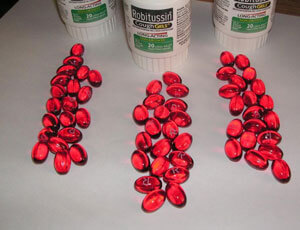- Over-the-Counter Drugs
- Prescription Drugs
While not scheduled by the DEA, DXM is still a dangerous drug because:
- Most overdoses result in an emergency room trip
- When used with other drugs, it can be life-threatening
- Harmful side effects including liver damage, rapid heart rate, vomiting, seizures and coma
What is DXM?
DXM is short for dextromethorphan–an ingredient in many over-the-counter cough suppressants. DXM is found in more than 120 cold medications, alone or in combination with analgesics, antihistamines, decongestants and expectorants.
Common names include CCC, Dex, DXM, Poor Man’s PCP, Robo, Rojo, Skittles, Triple C and Velvet.
How is DXM misused?
Available at almost any pharmacy or supermarket, products with high concentrations of DXM are targets for people seeking to misuse and subsequently abuse it. DXM products and powder can also be purchased on the Internet. People take various amounts, some ingesting 250 to 1,500 milligrams in a single dosage.
Misuse of DXM is referred to as robotripping, skittling, or dexing – terms derived from the products most commonly misused, Robitussin and Coricidin HBP. DXM misuse has traditionally involved drinking a large amount of liquid cough medicine; however, misuse of tablet and gel capsule preparations has increased. DXM tablets and capsules are easier to consume and eliminate the need to drink large volumes of syrup. The tablets and capsules are also easily transported and concealed, allowing a user/abuser/addict to “use” throughout the day.
How does DXM affect a person?
People who misuse DXM experience a variety of dissociative effects including euphoria and hallucinations. DXM effects can also include confusion, inappropriate laughter, agitation, paranoia, the feeling of floating and changes in hearing and touch. Depending on the degree of misuse, the user can experience effects ranging from mild stimulation to complete out-of-body sensations. Due to loss of motor control and sense impairment, users are at risk of injuring themselves and others. Effects of DXM can last up to six hours.
Drugs with similar effects include marijuana and ecstasy. In high doses, DXM’s out-of-body effects are similar to ketamine and PCP.
What are the health effects/risks of using DXM?
Users who take high doses of DXM also risk hyperthermia (exceptionally high fever), particularly if they use DXM in a hot environment or during physical activity. Users can also suffer from abdominal pain, irregular heartbeat, high blood pressure, headache, numbness of the fingers and toes, loss of consciousness and seizures.
A DXM overdose can be treated in an emergency room setting and generally does not result in severe medical consequences. When taken in combination with other drugs, DXM-related deaths are at their highest rate, particularly in the case of antidepressants. Over the counter products with DXM often contain other ingredients with their own harmful side effects. Acetaminophen, chlorpheniramine and guaifenesin have been known to cause liver damage, rapid heart rate, lack of coordination, vomiting, seizures and coma.



